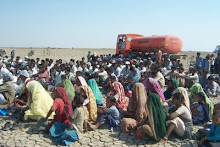Wild Ass Sanctuary, Little Rann of Kutch
Property names are listed in the language in which they have been submitted by the State Party.
India (Asia and the Pacific) Date of Submission:15/03/2006
Category: Natural
Submited by: Nature Conservation Foundation and Ashoka Trust for Research in Ecologyand Environment
Coordinates: 220 55 N to 240 35 N 700 30 E to 710 45 E
Ref. : 2105
Description
The Wild Ass Sanctuary is located in the Little Rann of Kutch of the Gujarat State in India. It covers an area of 4954 km². The Sanctuary is named after a sub species of wild ass (Equus hemionus khur), the last population of which it harbours. The Rann is one of the most remarkable and unique landscapes of its kind in the entire world. It is a vast desiccated, unbroken bare surface of dark silt, encrusted with salts which transforms into a spectacular coastal wetland after the rains.The present saline desert of the Little Rann (saline desert-cum-seasonal wetland) of Kutch is believed to have been shallow sea. The variety of the geomorphic facets of Kutch such as the present surface configuration, its landforms, drainage characteristics and relief pattern clearly reveals a complex interplay of tectonics, sea-level changes and lithology as also erosion and deposition.The Rann can be considered a large ecotone, a transitional area between marine and terrestrial ecosystems. During monsoon, the Rann gets inundated for a period of about one month. It is dotted with about 74 elevated plateaus or islands, locally called 'bets'. The largest plateau called Pung Bet has an area of 30.5 km² and the highest island Mardak is 55 m.The vast cover of saline mudflats in the Sanctuary has no vegetation, except on the fringes and bets. Vegetation is largely xerophytic with the ground cover predominated by ephemerals. Their active growth is triggered by the advent of monsoon rains. Although the islands and fringes both have been colonized by Prosopis juliflora, the islands have a richer floral diversity than that of the fringes. 253 flowering plant species have been listed, out of which the number of species of trees was 18, shrubs-23, climbers/twiners-18, herbs-157 and grasses-37. Bets and fringe area of extensive marine saline flats of the Little Rann of Kutch mainly support a variety of indigenous plants like Suaeda spp., Salvadora persica, Capparis decidua, Capparis deciduas, Calotropis procera, Tamarix sp., Aeluropus lagopoides, Cressa cretica, Sporobolus spp., Prosopis Cineraria, etc. The dominant families representing more than 10 species are Fabaceae, Asteraceae, Cyperaceae and Poaceae. Herbaceous taxa are predominant over shrubs and trees. 107 species of algae are present in the water bodies of the area.The Sanctuary is habitat to about 93 species of invertebrates, including 25 species of zooplanktons, 1 species of annelid, 4 crustaceans, 24 insects, 12 molluscs and 27 spiders. Totally 4 species of amphibians (frogs and toads) and 29 species of reptiles (2 species of turtles, 14 species of lizards, 12 snakes and 1 crocodile) occur. The mixing of tidal water from the Gulf of Kutch with the freshwater discharged from the rivers takes place in the Little Rann of Kutch, making it an important spawning ground for prawns. Metapenaeus kutchensis is the most dominant and important prawn in the area. The sanctuary provides an important feeding, breeding and roosting habitat for a large number of birds due to its strategic location on bird migration route and its connection with the dynamic Gulf of Kutch. According to an estimate about 70,000-75,000 birds nests in an area spread over 250 acres. Nine mammalian orders with 33 species/subspecies have been reported from the Little Rann of Kutch, including the world’s last population of the khur sub-species of the wild ass.
Property names are listed in the language in which they have been submitted by the State Party.
India (Asia and the Pacific) Date of Submission:15/03/2006
Category: Natural
Submited by: Nature Conservation Foundation and Ashoka Trust for Research in Ecologyand Environment
Coordinates: 220 55 N to 240 35 N 700 30 E to 710 45 E
Ref. : 2105
Description
The Wild Ass Sanctuary is located in the Little Rann of Kutch of the Gujarat State in India. It covers an area of 4954 km². The Sanctuary is named after a sub species of wild ass (Equus hemionus khur), the last population of which it harbours. The Rann is one of the most remarkable and unique landscapes of its kind in the entire world. It is a vast desiccated, unbroken bare surface of dark silt, encrusted with salts which transforms into a spectacular coastal wetland after the rains.The present saline desert of the Little Rann (saline desert-cum-seasonal wetland) of Kutch is believed to have been shallow sea. The variety of the geomorphic facets of Kutch such as the present surface configuration, its landforms, drainage characteristics and relief pattern clearly reveals a complex interplay of tectonics, sea-level changes and lithology as also erosion and deposition.The Rann can be considered a large ecotone, a transitional area between marine and terrestrial ecosystems. During monsoon, the Rann gets inundated for a period of about one month. It is dotted with about 74 elevated plateaus or islands, locally called 'bets'. The largest plateau called Pung Bet has an area of 30.5 km² and the highest island Mardak is 55 m.The vast cover of saline mudflats in the Sanctuary has no vegetation, except on the fringes and bets. Vegetation is largely xerophytic with the ground cover predominated by ephemerals. Their active growth is triggered by the advent of monsoon rains. Although the islands and fringes both have been colonized by Prosopis juliflora, the islands have a richer floral diversity than that of the fringes. 253 flowering plant species have been listed, out of which the number of species of trees was 18, shrubs-23, climbers/twiners-18, herbs-157 and grasses-37. Bets and fringe area of extensive marine saline flats of the Little Rann of Kutch mainly support a variety of indigenous plants like Suaeda spp., Salvadora persica, Capparis decidua, Capparis deciduas, Calotropis procera, Tamarix sp., Aeluropus lagopoides, Cressa cretica, Sporobolus spp., Prosopis Cineraria, etc. The dominant families representing more than 10 species are Fabaceae, Asteraceae, Cyperaceae and Poaceae. Herbaceous taxa are predominant over shrubs and trees. 107 species of algae are present in the water bodies of the area.The Sanctuary is habitat to about 93 species of invertebrates, including 25 species of zooplanktons, 1 species of annelid, 4 crustaceans, 24 insects, 12 molluscs and 27 spiders. Totally 4 species of amphibians (frogs and toads) and 29 species of reptiles (2 species of turtles, 14 species of lizards, 12 snakes and 1 crocodile) occur. The mixing of tidal water from the Gulf of Kutch with the freshwater discharged from the rivers takes place in the Little Rann of Kutch, making it an important spawning ground for prawns. Metapenaeus kutchensis is the most dominant and important prawn in the area. The sanctuary provides an important feeding, breeding and roosting habitat for a large number of birds due to its strategic location on bird migration route and its connection with the dynamic Gulf of Kutch. According to an estimate about 70,000-75,000 birds nests in an area spread over 250 acres. Nine mammalian orders with 33 species/subspecies have been reported from the Little Rann of Kutch, including the world’s last population of the khur sub-species of the wild ass.
















.jpg)
.jpg)
.jpg)
.jpg)













No comments:
Post a Comment